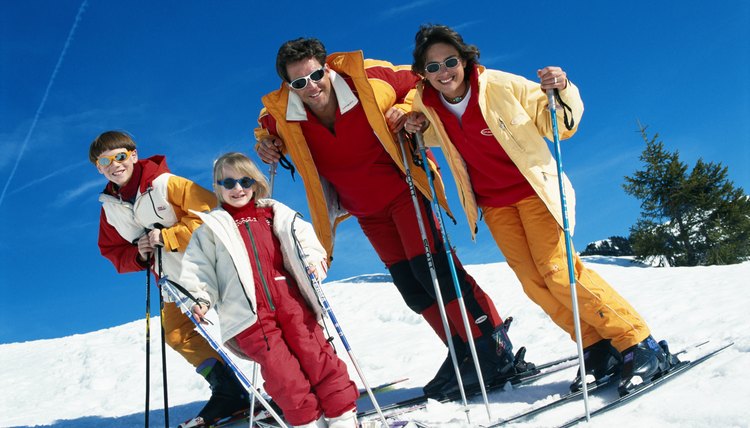What Is Traversing in Skiing?

Some skiers prefer a speedy descent, while others like to relax and enjoy the scenery while traversing more of the slope. On busy winter days, traversing is a great way to maximize your time on the slopes and minimize your time waiting in a lift line. Practicing traversing provides a great core and lower body workout, and is a great opportunity to master parallel turns and other controlled downhill techniques.
Definition
In downhill skiing, traversing involves skiing back and forth perpendicular to the slope. Once you traverse over to the far side of the trail, you perform a 180-degree turn and ski back to the opposite side of the trail. Traversing on easy runs allows you to enjoy covering more of the mountainside at a leisurely pace, while traversing on more difficult slopes is a great method for maintaining control throughout the run.
Proper Technique
Begin traversing by facing one edge of the trail, perpendicular to the downhill slope with your skis parallel. Rotate your body slightly so the uphill ski is farther forward than the downhill ski, and place a majority of your weight on the downhill ski. Begin moving by shifting your weight forward and rotating your ankles toward the hillside, so the inside edges of the skis are angled toward the hill. Once you reach the far edge of the trail, do a parallel turn and begin traversing in the opposite direction.
Safe Traversing
When skiing an empty slope, traversing is a very safe method, because it minimizes your velocity. When you're sharing the slope with skiers rapidly traveling straight downhill, traversing can pose more of a safety hazard, because you're constantly at risk of getting sideswiped by a virtual human missile. When you turn at the edge of a slope, glance uphill to make sure the coast is clear before beginning your next traversal; occasionally you may need to either stop or briefly angle more downhill to avoid intersecting the path of another skier. When traversing a busy, steep slope, it might be best to take a slightly more vertical angle so you're moving less against the flow of traffic. Conversely, if you find yourself traversing too quickly on a steep slope, you can point your skis farther uphill to slow your speed until you regain control.
Muscular Exertion
Traversing provides a wide range of muscles with an aerobic workout. Constantly engaging core and leg muscles while traversing requires a great deal of activity from your slow-twitch fibers, which are primarily fueled by oxygen. The glycogen-fueled, explosive muscle contractions required for you to turn at the end of each traversal provide a secondary anaerobic, strength building benefit. Traversing provides an intense workout for the gluteus maximus, particularly for skiers who have difficulty keeping their skis parallel. Effective parallel skiers enjoy greater benefits for the thigh, calf and quad muscles. Other muscles worked during traversal include your hamstrings, adductors, obliques and lower back muscles.
References
Writer Bio
Dan Howard is a sports and fitness aficionado who holds a master's degree in psychology. Howard's postgraduate research on the brain and learning has appeared in several academic books and peer-reviewed psychology journals.
